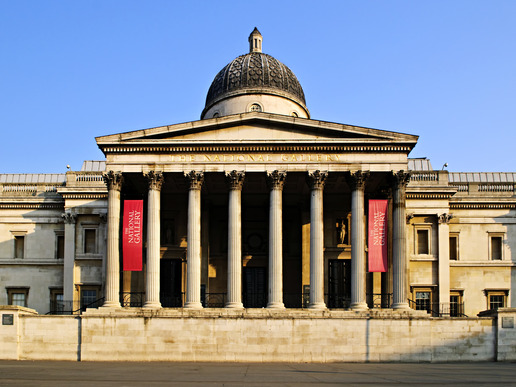The National Gallery stands on the former site of the King’s Mews. In 1826 nearby Carlton House, former home of the Prince Regent was demolished but its impressive columns were saved. Founded in 1824, it houses a collection of over 2,300 paintings dating from the mid-13th century to 1900.
The Gallery is an exempt charity, and a non-departmental public body of the Department for Culture, Media and Sport. Its collection belongs to the public of the United Kingdom and entry to the main collection is free of charge.
It came into being when the British government bought 38 paintings from the heirs of John Julius Angerstein, an insurance broker and patron of the arts, in 1824. After that initial purchase the Gallery was shaped mainly by its early directors, notably Sir Charles Lock Eastlake, and by private donations, which comprise two-thirds of the collection.
The resulting collection is small in size, compared with many European national galleries, but encyclopaedic in scope; most major developments in Western painting “from Giotto to Cézanne” are represented with important works.
In 1823 another major art collection came on the market, which had been assembled by the recently deceased John Julius Angerstein. Angerstein was a Russian-born émigré banker based in London; his collection numbered 38 paintings, including works by Raphael and Hogarth’s Marriage à-la-mode series. On 1 July 1823 George Agar Ellis, a Whig politician, proposed to the House of Commons that it purchase the collection.
In 1832 construction began on a new building by William Wilkins on the site of the King’s Mews in Charing Cross, in an area that had been transformed over the 1820s into Trafalgar Square. The location was a significant one, between the wealthy West End and poorer areas to the east.
The argument that the collection could be accessed by people of all social classes outstripped other concerns, such as the pollution of central London or the failings of Wilkins’s building, when the prospect of a move to South Kensington was mooted in the 1850s.
According to the Parliamentary Commission of 1857, “The existence of the pictures is not the end purpose of the collection, but the means only to give the people an ennobling enjoyment”. In the 20th century the Gallery’s late Victorian interiors fell out of fashion.
The Crace ceiling decorations in the entrance hall were not to the taste of the director Charles Holmes, and were obliterated by white paint. The North Galleries, which opened to the public in 1975, marked the arrival of modernist architecture at the National Gallery.
In the older rooms, the original classical details were effaced by partitions, daises and suspended roofs, the aim being to create neutral settings which did not distract from contemplation of the paintings.

Entrance to National Gallery building in London England
But the Gallery’s commitment to modernism was short-lived: by the 1980s Victorian style was no longer considered anathema, and a restoration programme began to restore the 19th- and early-20th-century interiors to their purported original appearance.
The museum’s main entrance is at the Sainsbury wing, to the left of the main building, where you’ll find the oldest paintings such as works by Giotto and Jan van Eyck. Late Renaissance works from Titian, Michelangelo and others can also be found in the west wing.
Seventeenth-century paintings from Italy, Flanders, Spain and the Netherlands are displayed in the north wing and features works from masters such as Rubens, Van Dyck, Rembrandt and Caravaggio. Paintings from the eighteenth and nineteenth centuries are on display in the east wing.